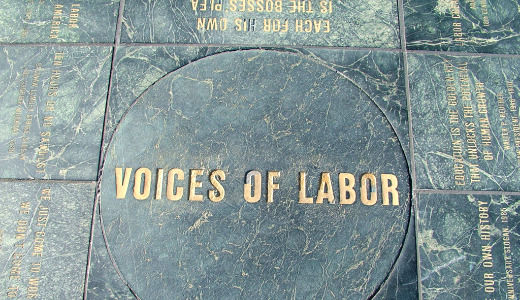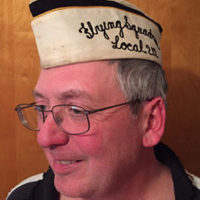
Straightening out the corners – you know, the hard edges in our lives. We all get ‘em; some do yoga, some get religion. Me, I ride. That’s what helps me to straighten the corners, round out the edges. “When you straighten out the corners, you get a circle. The circle is a symbol of life: there is no beginning and there is no end.” I read that once in a motorcycle book. “You straighten out the corners so you can see other people’s points of view, and you can understand a little more about them …. ‘cause we’re all Brothers and Sisters in this world.” Biker philosophy at its finest.
I’ve been having a hard time lately trying to soften the hard edges in my life. My ol’ man, Moses Dick, died this January. Nine days later, a pal of mine died as well. And a month later, my uncle passed away suddenly. Straightening out these corners has not been easy. Sometimes I laugh at these curve balls thrown down from Heaven as I swing my earthly aluminum bat, but most times I cry. But one thing remains certain: I need to draw inspiration and hope from the lives these men lived. They are a part of my history and I plan to pass it on down.
This is the 40th anniversary of the Great Postal Strike of 1970. Some of you reading this may have been participants in that eight days that changed the National Association of Letter Carriers (NALC). I want your stories to never be forgotten. Your courage and sacrifice has allowed me and my wife to do all the things that I’ve written about over the last eight years: namely travel the country via motorcycle to all 50 states and meet letter carriers all along the way. This has been a great honor and a humbling privilege. I know I am a result of two great parents, but also my economic privileges have been forged by the dedication and perseverance of those letter carriers who came before me. And not just the letter carriers; determined unionists and social activists have been laying my groundwork for many decades.
I have been involved in the Michigan Labor History Society for a couple of years now. I like going to the meetings because they call me “young man.” It’s quite a shame, actually, to be the youngest on the program committee at 50 years old. This group is responsible for the great monument, “Transcending,” located in Hart Plaza, in downtown Detroit. To be in the midst of this group while they are discussing labor history is, to me, like a hummingbird sucking up sweet nectar. I believe more of us, those who labor for a living, need to understand our roots. We take way too many of our good working conditions and benefits for granted. I am not a big fan of sitting in a classroom chair (just ask my Mom), so my idea of teaching is to do a Detroit labor history field trip. Detroit is a UAW (United Auto Workers) town, but also a very historical town for NALC history as well. Let me grab a beer as I take you on a tour.
First stop: the Fort Street Bridge at Miller Road. This bridge, at the border of Dearborn and Detroit, crosses the Rouge River. Looking north, the ominous stacks of the Ford Rouge steel plant billow black clouds of stinky smoke. Tugboats hug the shore, waiting to steer barges to the Detroit River, and the Morton salt mines lie underneath the southeast side of the bridge. The historic marker on the bridge reads:
On March 7, 1932 in the midst of the Depression, unemployed auto workers, their families and union organizers braved the bitter cold temperatures and gathered at this bridge, intent on marching to the Ford Rouge plant and presenting a list of demands to Henry Ford. Some 3,000 “hunger marchers” paraded down Miller Road. At the city limit Dearborn police blocked their path and hurled tear gas; the marchers responded with rocks and frozen mud. Near Gate #3 the demonstrators were bombarded with water from fire hoses and a barrage of bullets. In the end, five marchers were killed, 19 wounded by gunfire, and numerous others by stones, bricks and clubs. Newspapers alleged that the marchers were Communists but they were in fact people of all political, racial and ethnic backgrounds.
Dave Moore, the last survivor of the Ford Hunger March, just died October 26, 2009. He was 97 years old and a union activist until his death. These are his words about that event:
“When you drive down Miller Road, your tires run over the blood of our martyrs. And when you walk along the street, the soles of your shoes are walking where the blood ran in 1932. We need to tell our young people the story of how people sacrificed their lives to build a movement.”
Next stop: the Miller Road overpass leading to the main entrance of the Rouge plant. This was the catwalk workers used to go from the parking lot to the plant. On May 26, 1937, Walter Reuther and three union associates began to pass out leaflets to workers on the overpass during shift change. Ford was the last auto company to allow the UAW to organize its factories, and was not at all happy about union organizers giving leaflets to his workers.
Twenty-five cars filled with men in sunglasses arrived at the site and warned everyone, including newsmen and the Ladies Auxiliary Brigade, to get out of the area. Reuther and his partners were attacked brutally on that overpass by those thugs while Dearborn police did nothing to stop the violence. Women were beaten, as well, with one police officer pleading, “Stop beating her. You’ll kill her …” One union organizer was pushed off the bridge and fell 30 feet. Another was beaten so badly, he spent months in the hospital with a broken back. I saw the actual photos of the Ford Hunger March and the Battle of the Overpass victims as they lay in pools of blood. The images are horrific.
Next stop: Transcending, the Labor Legacy Project. This is the majestic steel circle reaching into the heavens in the forefront of Hart Plaza. Just across from the Joe Louis fist, this is labor’s gift to the city of Detroit. Our Letter Carriers Branch was one of the first contributors to the building of this project. If you have not done so, please visit this 63-foot-tall glorious monument. It is an inspiring sculpture with a spiraling granite walkway through an artist’s vision of labor history. Look for our Branch 3126 tribute plaque on the memorial wall.
Last stop; the Walter Reuther Library at Wayne State University. This is the resting place of all NALC official archives. It is also where the UAW places all of its archival history, as well as many other unions. Until June of this year there is a grand special exhibit of NALC history at the library. A group of us recently perused this fine display of letter carriers in action over the last 200 years and found it quite outstanding. There is quite a bit of 1970 strike history as part of this display. I highly recommend a family trip to the Reuther Library. Your kids need to know about labor history. Maybe they will even Twitter their friends about how much fun they’re havin’ in a library!
So let’s connect the dots. I’ve been accused of being a ramblin’ idiot so let’s sharpen our pencils and put them to paper.
Ford Hunger March…U
Battle of the Overpass..N
Postal Strike of 1970…….I
Labor Legacy Project……..O
NALC History Exhibit………N
I see the connection between all these things. It’s just working folks trying to fight for dignity and respect. It’s plain and simple to me. I am glad that I wrote this article. It’s helped me to straighten out the corners of my mind. Now I understand why the Labor Legacy Project is a circle. But look closely; there is a gap at its apex. There’s still a lot of work to be done. The future is unwritten.
The arc of history bends towards justice. – Martin Luther King, Jr.
P.S. This article was inspired by a proud, retired UAW member, Robert “Moses” Dick, 1939 – 2010. Two of his favorite sayings were, “Work Sucks!” and “Thank God for the Union.” You are gone, but never forgotten. Thanks, Pops!
John “Cementhead” Dick is an active member of the National Association of Letter Carriers, Branch 3126, Royal Oak, Mich.
Photo: Voices of Labor memorial in Detroit’s Hart Plaza. http://www.flickr.com/photos/cletch/ / CC BY 2.0










